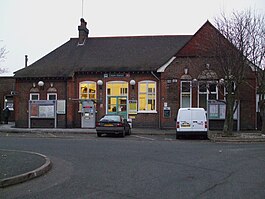Cheam railway station
| Cheam |
|
|---|---|

Main building
|
|
|
Location of Cheam in Greater London
|
|
| Location | Cheam |
| Local authority | London Borough of Sutton |
| Managed by | Southern |
| Station code | CHE |
| DfT category | D |
| Number of platforms | 2 |
| Accessible | Yes |
| Fare zone | 5 |
| National Rail annual entry and exit | |
| 2011–12 |
|
| 2012–13 |
|
| 2013–14 |
|
| 2014–15 |
|
| 2015–16 |
|
| Key dates | |
| 10 May 1847 | Opened |
| Other information | |
| Lists of stations | |
| External links | |
| WGS84 | 51°21′22″N 0°12′53″W / 51.356°N 0.2147°WCoordinates: 51°21′22″N 0°12′53″W / 51.356°N 0.2147°W |
|
|
|
Cheam railway station serves Cheam in the London Borough of Sutton. It is located on the Sutton & Mole Valley Lines section from Sutton to Epsom with trains to London Victoria and London Bridge both via Mitcham Junction and West Croydon.
In 1844 Cheam was on the planned route for the London to Portsmouth atmospheric railway. The section of line between Croydon and Epsom was part of the London & Croydon Railway company who promoted the Clegg and Samuda atmospheric principle, utilizing a 15 in (380 mm) pipe. This project failed, and Cheam station became part of the London, Brighton and South Coast Railway on 10 May 1847.
The station is almost 16 miles (26 km) from London Bridge station. Over the years Cheam station expanded, and was rebuilt and the rail bed widened in preparation for the installation of AC overhead electric services, which would have included the building of an additional central platform island. Due to the outbreak of the First World War, the full planned expansion was cancelled and was never completed. Nevertheless, the through lines were still in place until 1978 after the Bognor Regis and Portsmouth express services were withdrawn from the Sutton and Dorking route to serve an expanding Gatwick Airport. The wide space between the tracks still remains and shows where the fast lines had been laid prior their removal. The brick main buildings are on the down side of the station.
...
Wikipedia

